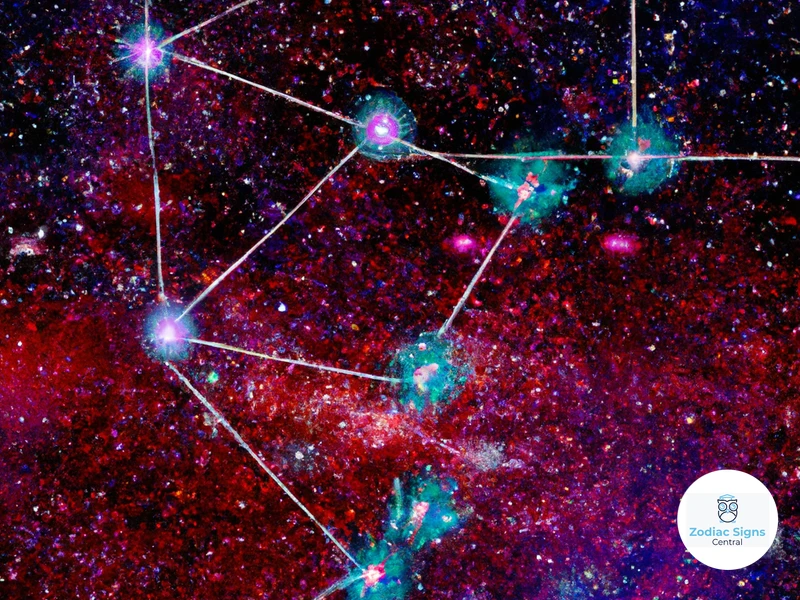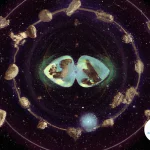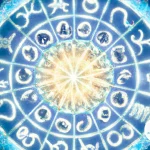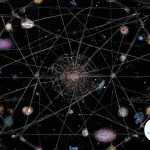Have you ever wondered why some couples seem to effortlessly connect and understand each other, while others constantly clash and struggle to find common ground? It turns out that the answer may lie in the complex study of synastry, which explores the role of astrological compatibility in relationships. Synastry examines the unique dynamic between two individuals by analyzing their birth charts and how their planetary positions interact. From zodiac sign compatibility to aspect analysis, synastry delves deep into the intricacies of cosmic harmony. In this article, we will explore the fascinating world of synastry and the valuable insights it offers in determining relationship compatibility. So, if you’re curious about how astrology can shed light on your love life, read on to discover the secrets of synastry.
What is Synastry?

Synastry is a fascinating field of study that explores the interaction and compatibility between two individuals in a relationship. It focuses on analyzing the elements of each person’s birth chart and how they interact with one another. A birth chart, also known as a natal chart, is a map of the sky at the time of a person’s birth. It includes the positions of the planets, the sun, and the moon, as well as the astrological signs they were in at that specific moment. Synastry takes these birth charts and compares them to determine the compatibility and potential challenges between two individuals.
In order to conduct a synastry analysis, astrologers examine various factors, such as the zodiac sign compatibility, planetary harmony, and aspect analysis. Zodiac sign compatibility assesses how well two individuals’ zodiac signs align with each other, taking into account the unique traits and characteristics associated with each sign. For example, a person with a Leo zodiac sign (/leo-zodiac-sign/) may be more compatible with another fire sign like Aries or Sagittarius (/sagittarius-career-exploration/) who shares their passion and adventurous spirit.
Planetary harmony in synastry looks at how the planets in each individual’s birth chart interact with one another. The positions and aspects of the planets, such as conjunctions, trines, or squares, can indicate the level of harmony or tension between the two individuals. For instance, if one person’s Venus is in harmony with the other person’s Mars, it suggests a strong physical and romantic attraction.
Aspect analysis in synastry involves examining the angles formed between the planets in each person’s birth chart. These angles, known as aspects, indicate the strength and nature of the relationship between the planets. For example, a conjunction aspect between the sun in one person’s birth chart and the moon in the other person’s birth chart signifies a deep emotional and soul connection. On the other hand, a square aspect between the sun and Saturn may indicate challenges in the relationship that require effort and compromise to overcome.
By analyzing these factors, synastry provides valuable insights into the dynamics of a relationship. It can help couples identify areas of compatibility and understand potential challenges they might face. Synastry offers a unique perspective on the harmonious and conflicting energies between two individuals.
Synastry is the study of astrological compatibility between two individuals based on their birth charts. It examines zodiac sign compatibility, planetary harmony, and aspect analysis to provide a comprehensive assessment of the relationship dynamics. By understanding the intricacies of synastry, individuals can gain valuable insights into the compatibility and potential challenges in their relationships.
The Importance of Relationship Compatibility
Relationship compatibility plays a significant role in the success and happiness of a partnership. When two individuals are compatible, they are more likely to understand and support each other, leading to a stronger and more fulfilling relationship. Compatibility encompasses various aspects, including emotional, intellectual, and even astrological compatibility. Understanding the compatibility between two individuals allows them to navigate challenges more effectively and build a solid foundation for their relationship. For example, a person with Scorpio traits (/scorpio-traits/) may seek a partner who can handle their intensity and emotional depth. Without compatibility, relationships can become strained and difficult, leading to potential conflicts and dissatisfaction. Understanding the importance of relationship compatibility is crucial in creating and maintaining a harmonious and lasting connection.
The Need for Compatibility in Relationships
Having compatibility in a relationship is crucial for its long-term success and happiness. When two individuals are compatible, it means that they share similar values, goals, and outlooks on life. This alignment allows them to connect on a deeper level, understanding and supporting each other’s dreams and aspirations. Compatibility also facilitates smooth communication and minimizes conflicts, as both partners are more likely to have a mutual understanding and respect for each other.
Emotional and intellectual compatibility plays a significant role in relationships. When two individuals have compatible emotional needs, they can provide the support and love that the other person requires. They are more likely to have shared interests and hobbies, which can strengthen the bond and create opportunities for quality time spent together. Intellectual compatibility, on the other hand, ensures that both partners can engage in meaningful conversations, share ideas, and stimulate each other’s minds.
Compatibility helps create a sense of stability and security in relationships. When partners are compatible, they are more likely to have similar expectations regarding commitment, family, and future plans. This shared vision allows them to build a strong foundation for a fulfilling partnership.
Lack of compatibility, on the other hand, can lead to dissatisfaction and challenges in the relationship. It can result in frequent misunderstandings, disagreements, and difficulty finding common ground. This misalignment can cause strain and even resentment between partners over time.
It is important to note that compatibility does not mean that partners need to be identical or have identical interests. Differences can be enriching and provide an opportunity for personal growth and learning. However, fundamental compatibility in values, communication styles, and long-term goals is essential for building a strong and fulfilling relationship.
The need for compatibility in relationships is vital for long-term happiness and success. Emotional, intellectual, and foundational compatibility all contribute to a deeply connecting and satisfying partnership. With compatibility, couples can navigate challenges, communicate effectively, and support each other in pursuing their dreams. Ultimately, compatibility sets the stage for a fulfilling and harmonious relationship.
Why Synastry Matters
Synastry matters because it offers valuable insights into the dynamics and compatibility of a relationship. Relationships can be complex, and understanding the underlying factors that contribute to their success or challenges is essential. Synastry allows individuals to gain a deeper understanding of themselves and their partners by examining the unique connection between their birth charts.
One of the primary reasons why synastry matters is its ability to provide insights into compatibility. By analyzing zodiac sign compatibility, planetary harmony, and aspect analysis, synastry can reveal how well two individuals align with each other astrologically. This information can help individuals make informed decisions about their relationships and navigate potential challenges.
For example, suppose individuals find that their zodiac signs are highly compatible based on their synastry analysis. In that case, it may provide them with a sense of reassurance and confidence in the relationship. On the other hand, if their birth charts show conflicting aspects or disharmony, it may serve as a warning sign of potential issues that need to be addressed.
Another reason why synastry matters is its role in understanding the dynamics of a relationship. It can shed light on the strengths and weaknesses of the partnership, helping couples identify areas of alignment and areas that may require compromise or work. By knowing which areas are in harmony and which may require attention, couples can proactively address challenges and work towards building a strong and fulfilling relationship.
Additionally, synastry matters because it can provide individuals with a greater sense of self-awareness. Through the analysis of their birth charts in relation to their partner’s birth chart, individuals can gain insights into their own strengths, weaknesses, and patterns of behavior in relationships. This self-awareness can foster personal growth and enable individuals to make conscious choices that contribute to healthier and more fulfilling connections.
Synastry matters because it offers a unique perspective on relationship compatibility and dynamics. It provides valuable insights into the strengths, challenges, and potential growth areas within a partnership. By understanding the astrological factors that contribute to the dynamics between individuals, synastry allows couples to make more informed decisions and work towards building fulfilling and harmonious relationships.
How Does Synastry Work?

Synastry employs various techniques to analyze the compatibility and dynamics between two individuals in a relationship. The process involves examining the key elements of each person’s birth chart, such as the planetary positions and their interactions. There are several components to consider when understanding how synastry works.
First, the astrologer looks at the elements of synastry, which include zodiac sign compatibility, planetary harmony, and aspect analysis. Each of these factors provides valuable insights into the compatibility between individuals. For example, zodiac sign compatibility compares the traits and characteristics associated with each person’s sign to see how well they align. Planetary harmony assesses how the planets in each individual’s chart interact with each other and whether they create a harmonious or tense energy. Aspect analysis, on the other hand, examines the angles formed between planets to determine the nature of their relationship.
Synastry techniques play a crucial role in understanding the dynamics between individuals. These techniques can include composite charts, which create a combined chart that represents the essence of the relationship. Transit analysis is another technique used in synastry, which evaluates the impact of current planetary movements on the relationship. By analyzing these techniques, astrologers can gain a deeper understanding of the relationship’s strengths, weaknesses, and potential areas of growth.
Synastry is a complex process that involves analyzing multiple elements of the birth charts and employing various techniques to assess compatibility and dynamics in a relationship. By exploring zodiac sign compatibility, planetary harmony, aspect analysis, composite charts, and transit analysis, synastry offers valuable insights into the unique dynamics between two individuals. Through this in-depth analysis, individuals can gain a better understanding of their compatibility and make informed decisions about their relationships.
Elements of Synastry
When delving into the world of synastry, it is essential to understand the key elements that come into play during the analysis. These elements provide valuable insights into the dynamics and compatibility between two individuals in a relationship.
1. Birth Charts: The birth charts, also known as natal charts, play a central role in synastry. Each individual’s birth chart is a unique map of the sky at the time of their birth, providing a snapshot of the positions of the planets, the sun, the moon, and other celestial bodies. These birth charts form the foundation for the synastry analysis.
2. Zodiac Signs: The zodiac signs are an essential component of synastry. Each zodiac sign represents distinct personality traits, characteristics, and elemental energies. By comparing the zodiac signs of both individuals, astrologers can gain insights into the compatibility between them. For instance, two individuals with compatible elemental energies, such as fire and air, may find it easier to connect and understand each other.
3. Planetary Aspects: Planetary aspects refer to the angles formed between the planets in each person’s birth chart. These aspects reveal the relationship and interaction between the respective planetary energies. Some common aspects include conjunctions, trines, squares, and oppositions. For example, a conjunction aspect suggests a blending of energies, while a square aspect may indicate tension and challenges that need to be addressed.
4. House Overlays: Houses in astrology represent different areas of life, such as relationships, career, family, and communication. During a synastry analysis, astrologers look at house overlays, which occur when one person’s planets fall into the houses of the other person’s birth chart. The house overlays can provide insights into the themes and dynamics that may be prominent in the relationship.
5. Composite Chart: The composite chart is a combined chart that represents the relationship itself. It is created by calculating the midpoint between the two individuals’ planets and points. The composite chart offers a unique perspective on the overall dynamics, strengths, and challenges within the relationship.
By considering and analyzing these elements, astrologers can gain a comprehensive understanding of the compatibility and dynamics between two individuals. Each element provides valuable information that contributes to the overall synastry analysis. Ultimately, the combination of these factors gives insight into the potential strengths, challenges, and overall compatibility within the relationship.
Synastry Techniques
Synastry techniques are diverse and varied, offering astrologers multiple tools to analyze and interpret the compatibility between two individuals. Here are some key techniques used in synastry:
1. Composite Chart: The composite chart is created by combining the midpoints of each person’s planets, points, and angles. This chart represents the shared energy and dynamics of the relationship itself, rather than individual personalities. It provides insights into the relationship’s purpose, strengths, and challenges.
2. Davison Relationship Chart: The Davison chart is derived by calculating the midpoint between the two individuals’ birth dates, times, and locations. It provides a snapshot of the relationship’s energy and can reveal its unique qualities and potential.
3. House Overlays: House overlays involve merging each person’s birth chart onto the other person’s chart, aligning the houses. This technique explores how each individual’s planets and points fall into the houses of the other person’s chart, shedding light on areas of potential compatibility and conflict.
4. Transits and Progressions: Transits and progressions involve analyzing the current positions of the planets in relation to each person’s birth chart. By examining the transits and progressions that affect the relationship chart, astrologers can gain insights into the timing of significant events, shifts in dynamics, and potential challenges or opportunities for growth.
5. Midpoints: Midpoints are the mathematical points between two planets or other significant elements in a birth chart. Synastry often focuses on the midpoints formed between the planets and points in each individual’s birth chart to understand the relationship’s dynamics and potential areas of connection or tension.
6. Comparing Rulerships: This technique involves comparing the rulers of the houses in each person’s birth chart. Astrologers analyze the interplay between the rulership planets to gain insights into the areas of life and themes that are significant in the relationship.
By employing these synastry techniques, astrologers can paint a comprehensive picture of the relationship dynamics. These techniques allow for a deeper understanding of the compatibility and potential challenges between two individuals, helping them navigate their relationship with greater awareness and insight.
Factors Analyzed in Synastry
In the field of synastry, several key factors are analyzed to determine the compatibility between two individuals. One important aspect is zodiac sign compatibility, which involves examining how well the characteristics and traits of each person’s zodiac sign align with one another. Each zodiac sign has its own unique qualities, strengths, and weaknesses, and understanding how these align or clash can provide insights into the overall compatibility of a relationship. Another factor considered in synastry is planetary harmony, which looks at how the positions of the planets in each person’s birth chart interact with one another. The aspects formed between the planets, such as conjunctions, trines, or squares, reveal the strength and nature of the relationship’s energies. Lastly, aspect analysis plays a crucial role in synastry, as it examines the angles formed between the planets in each individual’s birth chart. These aspects shed light on the dynamics and potential challenges within the relationship. By carefully analyzing these factors, synastry provides a comprehensive view of the compatibility between two individuals, allowing them to better understand their relationship dynamics.
Zodiac Sign Compatibility
Zodiac sign compatibility is a crucial aspect of synastry analysis. It involves assessing how well two individuals’ zodiac signs align with each other in terms of personality traits and characteristics. Each zodiac sign has its own unique energy and qualities, and understanding how they interact with each other can provide valuable insights into the compatibility between two people.
Here is a breakdown of zodiac sign compatibility and the general compatibility between each sign:
Aries (March 21 – April 19)
Strengths: Adventurous, independent, passionate
Compatibile signs: Leo, Sagittarius
Taurus (April 20 – May 20)
Strengths: Reliable, patient, sensual
Compatibile signs: Virgo, Capricorn
Gemini (May 21 – June 20)
Strengths: Curious, expressive, adaptable
Compatibile signs: Libra, Aquarius
Cancer (June 21 – July 22)
Strengths: Nurturing, loyal, intuitive
Compatibile signs: Scorpio, Pisces
Leo (July 23 – August 22)
Strengths: Confident, generous, passionate
Compatibile signs: Aries, Sagittarius (/sagittarius-career-exploration/)
Virgo (August 23 – September 22)
Strengths: Practical, analytical, loyal
Compatibile signs: Taurus, Capricorn
Libra (September 23 – October 22)
Strengths: Harmonious, diplomatic, charming
Compatibile signs: Gemini, Aquarius
Scorpio (October 23 – November 21)
Strengths: Intense, passionate, magnetic (/scorpio-traits/)
Compatibile signs: Cancer, Pisces
Sagittarius (November 22 – December 21)
Strengths: Adventurous, optimistic, independent
Compatibile signs: Aries, Leo (/leo-zodiac-sign/)
Capricorn (December 22 – January 19)
Strengths: Ambitious, disciplined, responsible
Compatibile signs: Taurus, Virgo
Aquarius (January 20 – February 18)
Strengths: Intellectual, innovative, independent
Compatibile signs: Gemini, Libra
Pisces (February 19 – March 20)
Strengths: Compassionate, artistic, intuitive
Compatibile signs: Cancer, Scorpio
While these compatibility matches are typically seen as more harmonious, it’s important to note that every individual is unique and may have different aspects in their birth charts that can impact compatibility. It’s also crucial to consider other factors in synastry analysis, such as planetary harmony and aspect analysis, to get a comprehensive understanding of relationship dynamics.
Zodiac sign compatibility is a fundamental aspect of synastry that helps determine the potential harmony between individuals based on their zodiac signs. Understanding the compatibility between different signs can provide valuable insights into the overall compatibility and dynamics of a relationship.
Planetary Harmony
Planetary harmony is a crucial aspect of synastry that examines the interaction between the planets in the birth charts of two individuals. It focuses on identifying how the positions and aspects of the planets align or conflict with each other, ultimately influencing the compatibility and dynamics of the relationship.
In synastry, the positions of the planets in the birth chart reveal important information about an individual’s personality, desires, and needs. When comparing two individuals’ birth charts, astrologers pay close attention to the planets that directly interact with one another.
One key concept in planetary harmony is the idea of “mutual reception.” This occurs when two planets are placed in each other’s ruling signs, creating a harmonious exchange of energy. For example, if one person’s Venus is in the sign of Taurus and the other person’s Venus is in the sign of Libra, this mutual reception enhances the compatibility between the two individuals in matters of love, beauty, and harmony.
Trines and sextiles are also important aspects considered in planetary harmony. Trines occur when planets are approximately 120 degrees apart, while sextiles occur when planets are approximately 60 degrees apart. Both aspects indicate a harmonious flow of energy, with trines being more potent. For instance, if one person’s Sun forms a trine aspect with the other person’s Moon, it suggests a natural understanding and compatibility between their core essence and emotional needs.
On the other hand, challenging aspects such as squares and oppositions can indicate areas of tension or conflict in the relationship. Squares occur when two planets are approximately 90 degrees apart, while oppositions occur when two planets are approximately 180 degrees apart. These aspects can create obstacles and challenges that need to be addressed and overcome for the relationship to thrive. For example, if one person’s Mars squares the other person’s Saturn, it may signify a clash between their assertive and disciplined energies.
In synastry, the overall planetary harmony between two individuals in a relationship is assessed by considering the strength, nature, and number of harmonious and challenging aspects. A balance between harmonious and challenging aspects is often considered ideal, as it promotes growth, understanding, and balance in the relationship.
Understanding planetary harmony in synastry allows individuals to gain insights into the compatibility and potential challenges in their relationship. It provides a deeper understanding of how the planets interact and influence the dynamics between two individuals, shedding light on the areas where there is natural alignment and areas that may require effort and compromise to navigate.
Planetary harmony in synastry plays a significant role in assessing the compatibility and dynamics between two individuals. It examines the interaction and alignment of the planets in their birth charts, including mutual reception, trines, sextiles, squares, and oppositions. By understanding the planetary harmony, individuals can gain valuable insights into the natural alignment and potential challenges in their relationship.
Aspect Analysis
Aspect analysis is a crucial component of synastry that focuses on the angles or aspects formed between the planets in each person’s birth chart. These aspects provide valuable insights into the nature of the relationship and the dynamics between the individuals involved. Here are some of the most commonly analyzed aspects in synastry:
1. Conjunction: A conjunction occurs when two planets are within a few degrees of each other in the same zodiac sign. This aspect suggests a merging of energies and a strong connection between the individuals. For example, a Venus conjunction between two people may indicate a deep emotional bond and strong romantic attraction.
2. Trine: A trine occurs when two planets are approximately 120 degrees apart, forming an equilateral triangle. This aspect signifies harmony and ease between the planets involved. Trines indicate compatibility and a natural flow of energy between the individuals. For instance, a Sun trine Moon aspect suggests emotional understanding and shared values.
3. Square: A square occurs when two planets are about 90 degrees apart, resulting in a tense and challenging aspect. This aspect indicates potential conflicts and differences between the individuals. Squares can be indicative of ongoing power struggles and the need for compromise and growth. An example would be a Mars square Saturn aspect, which may signify struggles with assertiveness and control in the relationship.
4. Opposition: An opposition occurs when two planets are approximately 180 degrees apart, forming a straight line across the zodiac circle. This aspect signifies a polarity or tension between the energies represented by the planets involved. Opposites attract, but they also bring about challenges and the need for balance. For instance, a Venus opposition between two people may indicate a strong initial attraction, but also the potential for power struggles and the need to find a compromise.
5. Sextile: A sextile occurs when two planets are approximately 60 degrees apart. This aspect represents opportunities, cooperation, and positive interactions between the individuals. Sextiles can indicate areas of shared interests and the potential for growth in the relationship. For example, a Mercury sextile Mars aspect suggests intellectual compatibility and the ability to communicate effectively.
When interpreting aspect analysis in synastry, it’s important to consider both the individual planets involved and the signs they are in. The signs add layers of meaning and influence how the aspects manifest in the relationship. By analyzing the aspects between the planets in each person’s birth chart, astrologers can gain deeper insights into the strengths, challenges, and overall dynamics of the relationship.
Interpreting Synastry Results

Interpreting synastry results is a crucial step in understanding the compatibility and dynamics between two individuals. One aspect of interpreting synastry results involves understanding compatibility ratings. These ratings provide insight into the overall harmony and potential challenges in the relationship. For example, a high compatibility rating indicates a strong connection and compatibility between the individuals, while a low rating may suggest areas of friction and potential conflicts. Another aspect of interpreting synastry results is identifying complementary energies. By analyzing the interactions of the planets and aspects in the birth charts, astrologers can pinpoint areas where the individuals’ energies complement and support each other, leading to a harmonious and balanced relationship. Additionally, it is essential to explore potential challenges revealed in synastry results. These challenges can be seen through conflicting aspects or placements that may require understanding, communication, and compromise. Understanding and addressing these challenges can help couples navigate and strengthen their relationship. With careful interpretation, synastry results offer valuable insights into the compatibility, strengths, and areas of growth within a relationship.
Understanding Compatibility Ratings
When analyzing the compatibility ratings in synastry, it is important to have a clear understanding of what they represent. These ratings provide insight into the level of compatibility between two individuals based on their birth charts. While no rating is definitive or absolute, they serve as a useful guide in determining the potential harmony or challenges within a relationship.
Compatibility ratings in synastry are typically measured on a scale from low to high. A high compatibility rating suggests a strong alignment of energies, indicating a greater chance for a harmonious and fulfilling relationship. Conversely, a low compatibility rating may indicate differences and potential conflicts that could require more effort and understanding to overcome.
One commonly used rating system is the five-star rating, which assigns a certain number of stars based on the level of compatibility. For example, a four or five-star rating suggests a high level of compatibility, indicating strong affinity and shared values. On the other hand, a one or two-star rating may indicate a lower level of compatibility, signaling potential challenges and differences in temperament.
It’s important to note that compatibility ratings can vary across different aspects of the relationship. For example, two individuals may have a high compatibility rating in terms of emotional connection, but a lower rating in terms of communication or long-term goals. It’s crucial to consider the overall picture and not solely rely on a single rating to assess the entire relationship.
Additionally, it’s important to remember that compatibility ratings are not fixed or set in stone. Relationships evolve and change over time, and individuals have the capacity to grow and adapt. A low compatibility rating doesn’t necessarily mean the relationship is doomed, and a high rating doesn’t guarantee a perfect partnership. It is essential to take compatibility ratings as a helpful tool rather than a definitive judgment.
Understanding compatibility ratings in synastry allows individuals to gain insights into the potential dynamics of their relationship. By considering these ratings in conjunction with other factors and personal experiences, individuals can navigate their relationships with a deeper understanding of the strengths and challenges they may encounter. Ultimately, compatibility ratings serve as a valuable guide in fostering open communication, understanding, and growth within a relationship.
Identifying Complementary Energies
Identifying complementary energies is a crucial aspect of synastry that helps individuals understand how they can harmonize and support each other in a relationship. Complementary energies refer to qualities, traits, and strengths that individuals possess which complement and enhance one another. By recognizing these complementary energies, couples can foster a deeper connection and create a more balanced relationship.
In synastry, astrologers analyze various aspects of the birth charts to identify these complementary energies. One way to identify complementary energies is through the examination of the elements and modalities of the zodiac signs. The four elements – fire, earth, air, and water – represent different energies and qualities. For example, a person with a fire sign, such as Aries or Leo, brings passion, enthusiasm, and a dynamic nature to the relationship. This energy can complement the grounded and practical nature of an earth sign, like Taurus or Virgo. Through this understanding, both individuals can appreciate and draw upon each other’s unique strengths, creating balance and harmony.
Another aspect of identifying complementary energies is through the analysis of planetary placements. Each planet symbolizes different aspects of a person’s personality and influences their behavior and expression. For instance, someone with a dominant Mercury placement might excel in communication and intellectual pursuits. This energy can complement a partner with a dominant Venus placement, bringing harmony, beauty, and emotional depth to the relationship.
Additionally, synastry examines the aspects between the planets in each individual’s birth chart to identify how their energies interact. Harmonious aspects, such as trines and sextiles, indicate a natural flow and compatibility between certain energies. For example, a trine aspect between Venus and Mars suggests a strong physical and romantic connection. On the other hand, challenging aspects, like squares and oppositions, can indicate areas of tension and potential conflict. These aspects present opportunities for growth and learning in the relationship.
By identifying complementary energies in synastry, couples can appreciate and value each other’s unique qualities. This understanding allows them to navigate challenges together and build a relationship based on mutual support and growth. It is essential to remember that complementary energies do not mean individuals need to be identical or identical in every aspect. Rather, it is about finding a balance between their strengths and weaknesses and embracing their differences.
Identifying complementary energies is a vital aspect of synastry, helping couples understand how their unique qualities can harmonize and support each other in a relationship. By analyzing zodiac sign elements, planetary placements, and aspects, individuals can recognize and appreciate each other’s strengths and create a balanced and fulfilling partnership. Embracing complementary energies fosters deeper connections and enhances the overall compatibility of the relationship.
Exploring Potential Challenges
Exploring potential challenges is a crucial aspect of synastry analysis when determining relationship compatibility. While synastry helps identify areas of harmony and compatibility, it also sheds light on the potential obstacles and difficulties that may arise in a relationship. These challenges can arise from conflicting planetary aspects and positions between the individuals’ birth charts.
One potential challenge that may be revealed through synastry is a square aspect between key planets. A square aspect occurs when two planets are approximately 90 degrees apart, creating a tense and challenging energy between them. For example, if one person’s moon is square to the other person’s Saturn, there may be emotional tensions and difficulties in expressing feelings and nurturing the relationship. Understanding this potential challenge can help both individuals work on communication and finding a balance in the relationship.
Another challenge that synastry can uncover is the presence of opposition aspects. Opposition aspects occur when two planets are approximately 180 degrees apart, creating a sense of polarization and contrasting energies. For instance, if one person’s Mars opposes the other person’s Venus, there may be a constant struggle in reconciling their desires and needs. Recognizing this potential challenge can encourage open dialogue and compromise to find a harmonious balance.
Additionally, synastry can reveal areas where the individuals’ energies may clash due to different elemental strengths. Each zodiac sign is associated with one of the four elements: fire, earth, air, and water. If one person’s chart is dominated by fiery Aries energy, while the other person’s chart is dominated by watery Cancer energy, their elemental differences could lead to conflicts in expressing emotions and taking action. Awareness of these potential challenges can help both individuals find ways to bridge their differences and cultivate understanding and empathy.
Exploring potential challenges through synastry analysis is crucial for relationship growth and development. It allows couples to anticipate areas where they may face difficulties and proactively work on solutions. It’s important to remember that while synastry can highlight potential challenges, it shouldn’t be seen as definitive. Every relationship is unique, and individual effort, communication, and compromise play essential roles in overcoming obstacles and building a strong and thriving partnership.
Using Synastry to Find Your Ideal Partner
Using synastry as a tool to find your ideal partner can be an enlightening and empowering process. By comparing and analyzing astrological profiles, synastry can provide valuable insights into the compatibility and potential harmony between two individuals. One of the key aspects to consider is matching astrological profiles, where the birth charts of both individuals are compared to identify areas of similarity and alignment. This includes examining the zodiac signs, planetary positions, and aspects within the charts. Finding someone whose birth chart complements and harmonizes with your own can indicate a strong potential for compatibility and a deeper connection. Additionally, synastry can help identify the long-term potential of a relationship by assessing the compatibility of the core elements in each individual’s chart. It can reveal common values, goals, and shared interests that contribute to a strong foundation for a lasting partnership. Synastry plays a significant role in personal growth, as it highlights areas of challenge and growth potential within a relationship. By understanding the dynamics between two people, synastry can guide individuals to develop greater self-awareness and strive for personal development. Whether you are seeking a romantic partner or a life partner, utilizing synastry offers valuable insights that can steer you towards finding your ideal match.
Matching Astrological Profiles
Matching astrological profiles is a key aspect of synastry that helps individuals determine compatibility in relationships. When comparing birth charts, astrologers look for similarities and commonalities between the two individuals’ astrological profiles. This involves analyzing the placement and aspects of the sun, moon, rising sign, and other significant planets.
The sun sign represents one’s core essence, personality traits, and ego. When the sun signs of two individuals align harmoniously, it can create a sense of understanding and compatibility. For example, if both individuals have sun signs in fire signs like Aries, Leo, or Sagittarius, (/sagittarius-career-exploration/) they may share a zest for life, passion, and enthusiasm.
The moon sign, on the other hand, reflects emotions, instincts, and inner desires. When the moon signs of two individuals are compatible, it indicates a natural emotional connection and understanding. For instance, if one person has a moon in sensitive and nurturing Cancer, and the other person has a moon in emotional and intuitive Pisces, (/scorpio-traits/) they may have a deep emotional bond and empathy towards each other.
The rising sign, also known as the ascendant, represents the persona and the first impression one gives to the world. When the rising signs of two individuals align favorably, it can create a sense of attraction and compatibility on a superficial level. For instance, if one person has a rising sign in charming and sociable Libra, and the other person has a rising sign in charismatic and confident Leo, (/leo-zodiac-sign/) there may be an instant spark and attraction between them.
In addition to these key factors, astrologers also examine the placement and aspects of other significant planets, such as Venus, Mars, and Mercury, in each individual’s birth chart. These planets influence areas such as romantic compatibility, sexual chemistry, communication styles, and intellectual connection.
Matching astrological profiles through synastry allows individuals to gain a deeper understanding of their compatibility and potential areas of connection in a relationship. However, it’s important to remember that astrology is just one tool among many in understanding relationships, and there are numerous other factors, such as personal values, communication, and shared goals, that also contribute to a successful and harmonious partnership.
Identifying Long-Term Potential
Identifying long-term potential is an essential aspect of synastry analysis when it comes to relationship compatibility. It involves examining the various factors in a couple’s birth charts to determine if their compatibility extends beyond initial attraction and can lead to a lasting and fulfilling partnership.
One of the key elements in identifying long-term potential is assessing the placement of the sun and moon in each person’s birth chart. The sun represents the core essence and identity of an individual, while the moon represents their emotions, instincts, and needs. When the sun and moon in both charts form a harmonious aspect, such as a trine or a conjunction, it indicates a strong emotional connection and an alignment of values.
Another crucial factor is the placement of Venus and Mars, which represent love and desire respectively. When Venus and Mars form positive aspects, such as a conjunction or a trine, it suggests a strong physical attraction and a shared understanding of each other’s needs and desires. This alignment of love and desire is essential for the sustainability of a relationship in the long run.
The position of Jupiter, the planet of expansion and growth, plays a significant role in determining long-term potential. If Jupiter forms favorable aspects with personal planets like the sun, moon, Venus, or Mars, it indicates a potential for growth, abundance, and positive experiences in the relationship. This alignment can bring about opportunities for personal and shared development, leading to a fulfilling and successful partnership.
In addition to planetary placements, aspects such as Saturn and Pluto should also be considered when identifying long-term potential. Saturn represents responsibility, commitment, and structure, while Pluto represents transformation and deep emotional connection. If these planets form favorable aspects with personal planets, it suggests a strong foundation built on stability, trust, and the potential for transformation and personal growth within the relationship.
While identifying long-term potential through synastry is insightful, it’s important to remember that it is not a definitive predictor of relationship success. Other factors such as individual personalities, communication skills, and external influences also play significant roles. However, synastry can provide valuable insights into the cosmic compatibility between two individuals and help identify if there is potential for a lasting and fulfilling relationship.
The Role of Synastry in Personal Growth
The role of synastry in personal growth extends beyond the realm of romantic relationships. While synastry is commonly used to assess compatibility between partners, it also offers valuable insights into an individual’s own personal journey. By analyzing the birth chart and understanding the dynamics between planetary positions, synastry can provide individuals with a deeper understanding of their strengths, weaknesses, and opportunities for growth.
One significant aspect of synastry’s role in personal growth is the identification of complementary energies. Through synastry analysis, individuals can gain insight into the areas where they naturally align with others and where they can create harmonious partnerships. For example, if someone has a strong conjunction between their Mars and another person’s Venus, it suggests a natural synergy between their assertiveness and the other person’s desires, leading to mutual support and fulfillment.
Synastry also sheds light on potential challenges that individuals may encounter in their personal growth journey. It reveals where conflicting energies or difficult aspects may arise, highlighting areas that require conscious effort and self-awareness. By acknowledging these challenges, individuals can proactively work on resolving internal conflicts and promoting personal growth. For example, if an individual’s Moon is in square aspect with another person’s Saturn, it may indicate emotional limitations or a sense of insecurity that needs to be addressed for personal development.
Synastry can help individuals embrace their unique qualities and unlock their full potential. By understanding their birth chart’s unique configurations, individuals can recognize their innate talents, strengths, and weaknesses. This knowledge empowers individuals to make informed choices, embrace their authentic selves, and pursue growth opportunities that align with their astrological makeup.
Additionally, synastry can act as a guiding tool for personal development. It illuminates the areas where individuals may need to focus their efforts and provides a roadmap for self-improvement. By identifying the aspects and planets in their birth chart that require attention, individuals can actively work on developing those specific qualities. Whether it’s enhancing communication skills by harnessing the power of Mercury or cultivating emotional intelligence through working with the Moon, synastry acts as a personalized guide for self-growth.
The role of synastry in personal growth extends beyond relationship compatibility. It helps individuals gain a deeper understanding of themselves, their strengths, weaknesses, and growth opportunities. Synastry allows individuals to embrace complementary energies, navigate potential challenges, and unlock their full potential. By utilizing the insights offered by synastry, individuals can embark on a transformative journey of self-discovery and personal development.
Comparing Synastry to Other Compatibility Methods

When it comes to determining relationship compatibility, there are various methods that people turn to. While synastry offers valuable insights based on astrological compatibility, it is important to understand how it differs from other well-known compatibility assessments. One popular method is Sun sign compatibility, which focuses on the compatibility between two individuals’ zodiac signs. While Sun sign compatibility provides a broad overview, synastry delves deeper by analyzing the entire birth charts of both individuals, taking into account the positions of planets and their interactions. Another method that people often use is numerology, which assigns meanings to numbers and calculates compatibility based on numerical patterns. While numerology can provide insights into personality traits and life paths, synastry offers a more nuanced understanding of relationship dynamics through the examination of astrological factors. Additionally, love languages are another way to assess compatibility, focusing on how individuals communicate and express love. While love languages offer valuable insights into understanding each other’s emotional needs, synastry looks beyond communication styles to analyze the energetic compatibility and potential challenges in a relationship. By comparing synastry to other compatibility methods, it becomes clear that synastry offers a unique and comprehensive approach to understanding relationship dynamics through the lens of astrology.
Synastry vs. Sun Sign Compatibility
Synastry and Sun Sign Compatibility are two approaches used to assess relationship compatibility in astrology, but they differ in their level of depth and insight. Sun Sign Compatibility is a more simplified method that focuses solely on comparing the zodiac signs of two individuals. It assumes that people born under the same zodiac sign will naturally be compatible because they share the same basic traits and qualities associated with that sign. This method is often found in generic horoscopes that provide compatibility predictions based solely on the individuals’ sun signs.
On the other hand, synastry takes a much more comprehensive approach by considering the entire birth charts of both individuals. It analyzes the positions of the planets, the aspects between them, and other elements that provide a more nuanced understanding of the relationship dynamics. While Sun Sign Compatibility provides a basic overview, synastry offers a deeper exploration of the unique energies and interactions between two people.
To highlight the differences between these two approaches, we can use a table:
| Synastry | Sun Sign Compatibility |
|---|---|
| Considers the entire birth charts of both individuals | Focuses solely on the zodiac signs |
| Analyzes planetary positions, aspects, and other factors | Assumes compatibility based on shared traits of the sun signs |
| Offers a more in-depth understanding of relationship dynamics | Provides a basic overview |
| Identifies specific areas of compatibility and potential challenges | Generalizes compatibility based on sun sign alone |
While Sun Sign Compatibility can provide a quick glimpse into the potential compatibility between two individuals, synastry offers a more detailed and nuanced analysis. By considering the entire birth charts and examining the various factors at play, synastry provides a deeper understanding of the unique dynamics that exist between two people.
Synastry vs. Numerology
When it comes to determining relationship compatibility, synastry and numerology are two distinct approaches that provide different insights. While synastry focuses on the astrological aspects of a relationship, numerology examines the numerical vibrations and energies associated with individuals. Here is a comparison of synastry and numerology:
| Synastry | Numerology |
|---|---|
| Synastry analyzes the compatibility between two individuals by examining their birth charts and the interaction of planetary positions. It takes into account zodiac sign compatibility, planetary harmony, and aspect analysis. | Numerology, on the other hand, studies the numerical vibrations and energies associated with individuals. It assigns numerical values to letters in a person’s name and birthdate, which are then used to analyze their personality traits and life path. |
| With synastry, the emphasis is on understanding the cosmic harmony and potential challenges between two people based on their astrological profiles. It provides a holistic view of the relationship dynamics. | Numerology focuses on the personal characteristics and life path of individuals. It provides insights into their strengths, weaknesses, and life purpose, which can impact their compatibility with others. |
| Synastry is rooted in the positioning of celestial bodies at the time of birth and the belief that these planetary influences shape personality traits and relationship dynamics. | Numerology is based on the belief that specific numbers hold symbolic meanings and vibrations. These vibrations can reveal personality traits, compatibility, and life patterns. |
| While synastry provides a detailed analysis of the astrological compatibility between two individuals, it does not take into account numerological factors. | Numerology offers a different perspective on compatibility by focusing solely on the numerical vibrations associated with individuals. It does not consider astrological aspects or planetary positions. |
Synastry and numerology are two distinct methods of understanding relationship compatibility. Synastry examines the astrological aspects of a relationship through birth chart analysis, while numerology focuses on the numerical vibrations and energies associated with individuals. Both approaches offer unique insights into compatibility, but they provide different perspectives and information. It’s up to individuals to decide which method resonates with them and aligns with their beliefs and preferences.
Synastry vs. Love Languages
Synastry and Love Languages are two different approaches to understanding relationship compatibility. While synastry focuses on astrological compatibility, Love Languages delve into the psychological and emotional aspects of a relationship.
Synastry analyzes the unique dynamic between two individuals based on their birth charts and the astrological elements. It seeks to uncover potential areas of harmony and challenges through zodiac sign compatibility, planetary harmony, and aspect analysis. On the other hand, Love Languages, as coined by author Gary Chapman, explore how individuals express and receive love.
The concept of Love Languages suggests that there are five primary ways in which people prefer to give and receive love: Words of Affirmation, Acts of Service, Receiving Gifts, Quality Time, and Physical Touch. Each individual has their own preferred love language(s), and understanding these preferences can lead to better communication and emotional connection.
While synastry provides insights through astrology, Love Languages focus on the emotional needs and communication styles of individuals in a relationship. Although they operate in different realms, they both seek to enhance relationship compatibility and foster understanding between partners.
It is important to note that synastry and Love Languages are not mutually exclusive; they can complement each other in understanding and nurturing a relationship. Incorporating both approaches can provide a holistic understanding of compatibility, considering both astrological factors and emotional needs.
By combining insights from synastry and understanding each other’s Love Languages, couples can foster a deeper level of understanding, empathy, and connection. It allows partners to communicate in ways that resonate with each other’s emotional needs and build a stronger foundation for their relationship.
Synastry and Love Languages offer distinct perspectives on relationship compatibility. Synastry explores astrological elements, while Love Languages focus on emotional needs and communication preferences. While they operate in different realms, the integration of both approaches can lead to a more comprehensive understanding of compatibility and nurturing a thriving relationship.
Common Misconceptions About Synastry
There are several common misconceptions about synastry that can lead to misunderstandings and false expectations. One misconception is blaming compatibility for relationship issues. While synastry provides insights into strengths and challenges, it is important to remember that compatibility is not the sole determining factor of a successful relationship. Other factors, such as communication, trust, and individual growth, also play crucial roles. Another misconception is believing that every zodiac sign is compatible. While some signs may naturally harmonize better than others, compatibility is not solely determined by sun sign alone. The complexities of synastry require a comprehensive analysis of all aspects and planetary positions. Lastly, it is a misconception to ignore individual personalities and solely rely on synastry. Each person brings their unique experiences, values, and behaviors to a relationship, which can greatly influence compatibility. It is important to consider both the synastry analysis and individual personalities when assessing relationship compatibility.
Blaming Compatibility for Relationship Issues
Blaming compatibility for relationship issues is a common misconception when it comes to synastry. While astrology can provide valuable insights into the strengths and challenges of a relationship, it is not the sole determining factor in the success or failure of a partnership. It is important to remember that compatibility is a dynamic concept that involves a combination of various factors, including communication, understanding, and personal growth.
Here are some reasons why blaming compatibility alone for relationship issues is not accurate:
1. Oversimplification: Compatibility is a complex concept that cannot be solely attributed to astrological factors. Relationships involve a multitude of dynamics, including personal values, communication styles, and shared experiences. It is unfair to place the blame solely on astrological compatibility without considering these other important aspects.
2. Individual Differences: Every individual is unique, and their birth chart is just one aspect of their personality. It is essential to acknowledge that personal growth, willingness to compromise, and effective communication play crucial roles in building a healthy and fulfilling relationship. Blaming compatibility for all relationship issues disregards the importance of personal responsibility and the need for ongoing effort and understanding.
3. External Factors: Relationship challenges can also stem from external sources such as external stressors, life circumstances, or unresolved personal issues. It is important to consider these factors rather than solely attributing them to compatibility. Blaming compatibility alone may overlook the need for addressing these external influences and finding appropriate solutions.
4. Growth and Adaptability: Relationships require continuous growth and adaptation. Even if there are initial compatibility challenges based on astrology, individuals can work together to understand and work through them. Synastry can provide insights into potential areas of disagreement, but it does not dictate the ultimate success or failure of a relationship. The willingness and ability of both individuals to grow, learn, and adapt are equally important.
Blaming compatibility alone for relationship issues is an oversimplification. While astrology and synastry offer valuable insights, it is important to recognize the multifaceted nature of relationships. Personal growth, effective communication, and understanding are just as crucial in building and maintaining healthy and fulfilling partnerships. Instead of solely blaming compatibility, focus on addressing individual differences, external factors, and the continuous effort required for personal and relational growth.
Believing Every Sign is Compatible
Believing that every astrological sign is compatible is a common misconception when it comes to synastry. While astrology provides valuable insights into relationship compatibility, it is essential to understand that not every sign will naturally harmonize with each other. Each sign has its unique qualities and characteristics, and not all of them will complement or align well with one another.
To debunk this misconception, let’s take a closer look at the compatibility between different zodiac signs:
1. Fire Signs (Aries, Leo, Sagittarius): Fire signs are known for their passion, energy, and assertiveness. They tend to get along well with other fire signs due to their shared enthusiasm and similar communication styles. However, they may clash with water signs (Cancer, Scorpio, Pisces) due to the contrasting emotional natures.
2. Earth Signs (Taurus, Virgo, Capricorn): Earth signs are practical, reliable, and grounded. They generally have great compatibility with other earth signs due to their shared values and work ethic. However, they may struggle with air signs (Gemini, Libra, Aquarius) as their approaches to life and communication styles can differ significantly.
3. Air Signs (Gemini, Libra, Aquarius): Air signs are intellectual, communicative, and sociable. They tend to have strong compatibility with other air signs due to their shared intellectual pursuits and mutual understanding. However, they may face challenges with earth signs as their focus on practicality and stability can clash with the air sign’s need for freedom and intellectual stimulation.
4. Water Signs (Cancer, Scorpio, Pisces): Water signs are emotional, intuitive, and deeply sensitive. They often connect well with other water signs due to their emotional depth and intuitive understanding. However, they may experience difficulties with fire signs as the water sign’s sensitivity may clash with the fire sign’s directness and assertiveness.
It’s important to note that while these general compatibility observations can provide insights, individual birth charts and other factors should also be taken into account in a comprehensive synastry analysis. Each person’s unique astrological makeup goes beyond just their sun sign, and other planetary placements and aspects play a significant role in determining compatibility.
So, it is crucial to recognize that not every sign will naturally align with one another. Compatibility in relationships is a complex interplay of various astrological factors, and it goes beyond just the sun sign. Embracing the diversity and nuances of different signs can lead to a more accurate understanding of synastry and relationship dynamics.
Ignoring Individual Personalities
Ignoring individual personalities is a common mistake when it comes to assessing relationship compatibility through synastry. While astrological compatibility is important, it is equally crucial to consider the unique traits, preferences, and values of each individual. Every person has their own distinct personality, shaped by their upbringing, life experiences, and personal beliefs.
When solely focusing on synastry and astrological indicators, there is a risk of overlooking the individuality of each person in the relationship. It’s important to remember that astrology is not the sole determining factor of a successful relationship. Other aspects such as communication skills, shared values, and personal growth play significant roles in fostering a healthy and fulfilling partnership.
By disregarding individual personalities, we undermine the importance of open communication and emotional connection in a relationship. A successful partnership requires understanding, empathy, and a willingness to embrace and appreciate each other’s unique qualities.
Each person brings their own strengths and weaknesses to a relationship, and it is through mutual understanding and acceptance that a strong foundation for compatibility can be built. While synastry can offer valuable insights into astrological compatibility, it should never overshadow the importance of recognizing, appreciating, and valuing the individual personalities of both partners.
Embracing the individual personalities of each person allows for a deeper level of understanding and connection in a relationship. It encourages open and honest communication, allowing partners to better navigate potential conflicts and differences. By acknowledging and valuing each other’s individuality, couples can create a more harmonious and fulfilling relationship that goes beyond astrological indicators.
While synastry provides valuable information about astrological compatibility, it should not overshadow the significance of acknowledging and embracing individual personalities. Relationships thrive when there is a balance between astrological harmony and understanding and appreciating the unique traits of each partner. By recognizing and valuing individual personalities, couples can foster deeper connections and create a solid foundation for long-lasting compatibility.
Tips for Enhancing Relationship Compatibility

Enhancing relationship compatibility is a goal for many couples looking to strengthen their bond and create a harmonious partnership. Here are some valuable tips to help achieve this:
1. Communication and Understanding: Open and honest communication is crucial in any relationship. Take the time to listen actively to your partner, express your needs and concerns clearly, and strive to understand each other’s perspectives.
2. Embracing Differences: Recognize that each individual brings their own unique qualities and strengths to the relationship. Embrace and appreciate these differences, as they can complement and enrich your connection.
3. Recognizing Growth Potential: Relationships thrive when both partners are committed to personal growth and development. Encourage and support each other’s aspirations, and be willing to grow together as a couple.
4. Nurturing Quality Time: Make it a priority to spend quality time together, engaging in activities that you both enjoy. This helps foster a deeper connection and strengthens the bond between you.
5. Resolving Conflict Constructively: Conflict is natural in any relationship, but it’s essential to approach it with respect and a willingness to find a constructive resolution. Practice active listening, compromise, and seek professional help if needed.
6. Showing Love and Appreciation: Small gestures of love and appreciation can go a long way in enhancing relationship compatibility. Express gratitude, show affection, and celebrate each other’s achievements and milestones.
7. Supporting Each Other’s Dreams: Encourage and support each other’s goals and aspirations. Be a cheerleader for your partner, offering encouragement and excitement for their dreams and ambitions.
By implementing these tips, couples can cultivate a deeper level of compatibility and create a strong foundation for a lasting and fulfilling relationship.
Communication and Understanding
Communication and understanding are key elements in any relationship, and they play a crucial role in enhancing compatibility. In the context of synastry, effective communication involves being able to openly express thoughts, feelings, and needs to your partner, while also actively listening and understanding their perspective. When both individuals in a relationship have strong communication skills, it allows for a deeper connection and a greater sense of harmony.
Synastry can provide insights into the communication styles of each individual based on their birth charts. For example, the placement of Mercury, the planet of communication, can indicate how one expresses themselves and processes information. A harmonious aspect between Mercury in both individuals’ charts suggests easy and fluid communication, where ideas are easily understood and effectively conveyed. On the other hand, challenging aspects or placements may indicate potential miscommunications, misunderstandings, or differences in communication styles that need to be addressed and worked through.
Understanding and empathy are also vital in fostering compatibility. Synastry can shed light on how individuals understand and relate to each other’s emotional needs. The Moon, representing emotions and nurturing, plays a significant role in this aspect. If the Moon in one person’s birth chart forms a harmonious aspect with the Moon in the partner’s chart, it suggests an innate understanding of each other’s emotional states and needs. This promotes a supportive and nurturing environment within the relationship.
However, challenges may arise in communication and understanding when there are conflicting aspects or placements. In such cases, it becomes essential for both individuals to engage in open and honest communication, addressing any issues or misunderstandings that may arise. By actively working on communication and seeking understanding, couples can overcome potential barriers and enhance compatibility within their relationship.
Communication and understanding are crucial aspects of relationship compatibility. Synastry can provide insights into each individual’s communication style, as well as how they understand and empathize with one another. By recognizing and working on areas of miscommunication or conflicting needs, couples can strengthen their bond and enhance compatibility. Effective communication creates a solid foundation for a strong and harmonious relationship, allowing for growth, compromise, and a deeper emotional connection.
Embracing Differences
Embracing Differences is a crucial aspect of enhancing relationship compatibility. In any relationship, it’s common for individuals to have different perspectives, preferences, and ways of handling situations. Instead of viewing these differences as obstacles, couples can choose to see them as opportunities for growth and learning. Embracing Differences involves acknowledging and respecting each other’s unique qualities and finding ways to incorporate them into the relationship. Here are some ways to embrace differences:
1. Open Communication: Establishing open and honest communication is key to understanding and appreciating each other’s differences. Encourage open dialogue where both partners can express their thoughts, feelings, and viewpoints without judgment. Active listening and empathetic understanding can help bridge the gap between differences and foster a deeper connection.
2. Seeking Compromise: Embracing differences often requires finding common ground through compromise. Both partners should be willing to meet halfway and find solutions that satisfy both parties. This involves being flexible and open-minded to alternative ideas and perspectives. Compromise allows for a harmonious balance in the relationship while honoring each other’s unique needs.
3. Learning and Growing: Differences provide an opportunity for personal growth and expansion. By embracing each other’s differences, couples can learn from one another’s experiences, perspectives, and skills. This leads to personal development and a broader understanding of the world. By being open to learning from each other, couples can deepen their connection and create a strong foundation for their relationship.
4. Respecting Boundaries: Embracing differences also means respecting each other’s boundaries. Each individual has their own set of values, beliefs, and personal boundaries. It’s important to recognize and honor these boundaries to maintain a healthy and harmonious relationship. Respecting boundaries creates a safe and comfortable space where individuals can freely express themselves without fear or judgment.
5. Celebrating Individuality: Embracing differences involves celebrating and appreciating each other’s individuality. Recognize that the unique qualities and characteristics that set each person apart contribute to the richness and diversity of the relationship. By celebrating individuality, couples can create an environment that encourages authenticity and self-expression.
Remember, embracing differences is not about trying to change or mold each other into the same person. Instead, it’s about embracing and valuing the uniqueness that each partner brings to the relationship. When couples actively embrace their differences, it fosters a sense of acceptance, understanding, and growth, ultimately enhancing compatibility and strengthening the bond between them.
Recognizing Growth Potential
Recognizing growth potential is an essential aspect of relationship compatibility. While compatibility is important, it’s also crucial to consider how a relationship can facilitate personal growth and development for both individuals involved. When assessing synastry results, it’s essential to look beyond the surface level compatibility and consider the potential for growth and evolution within the relationship.
Astrology can provide insights into the areas where growth is possible in a relationship. For example, if one person’s moon sign is in a harmonious aspect with the other person’s sun sign, it suggests emotional compatibility and the potential for mutual nurturing and support. This aspect can signify a safe and secure space for personal growth and vulnerability within the relationship.
Another way to recognize growth potential is by examining the challenging aspects in synastry. While these aspects may indicate initial difficulties or conflicts, they also provide opportunities for growth and transformation. For instance, a square aspect between two individuals’ Mars signs may initially lead to conflicts and power struggles. However, with conscious awareness and open communication, this aspect can stimulate personal growth in assertiveness, conflict resolution, and compromise.
Identifying growth potential also involves understanding each other’s personal goals, dreams, and aspirations. By aligning these aspects of life, a couple can support and encourage each other in their individual growth journeys. Synergy in goal-setting and mutual support can foster an environment of growth and accomplishment within the relationship.
It is important to note that recognizing growth potential doesn’t mean expecting change from one’s partner or trying to mold them into someone they’re not. Rather, it involves acknowledging and supporting each other’s individual ambitions and personal development. When both individuals in a relationship can pursue their own growth while also growing together, it creates a strong foundation for long-term compatibility and fulfillment.
Recognizing growth potential is an important aspect of relationship compatibility. Astrology can shed light on areas of the relationship where personal growth and development are possible. By understanding the aspects and dynamics in synastry, couples can create an environment that supports and nurtures each other’s growth. Recognizing and embracing growth potential within a relationship can lead to a deeper connection, personal fulfillment, and long-term compatibility.
Conclusion
In conclusion, synastry offers a fascinating and valuable tool for understanding relationship compatibility through the lens of astrology. By examining zodiac sign compatibility, planetary harmony, and aspect analysis, individuals can gain profound insights into the dynamics of their relationships. Synastry helps couples identify areas of compatibility and potential challenges, allowing them to navigate their relationships with a deeper understanding and awareness. It assists in identifying complementary energies and recognizing growth potential within the partnership. While synastry should not be seen as the sole determinant of relationship success, it can serve as a powerful tool for self-reflection, personal growth, and improving communication and understanding within a partnership. Ultimately, synastry provides a unique and insightful perspective that can enhance one’s understanding of relationship dynamics and contribute to fostering healthier, more harmonious connections. So, whether you’re seeking to deepen your current relationship or find your ideal partner, exploring the role of synastry can be an enlightening and rewarding journey.
Frequently Asked Questions

What is the main purpose of synastry?
The main purpose of synastry is to analyze the compatibility between two individuals in a relationship by examining their birth charts and the interaction of their planetary positions.
Is synastry limited to romantic relationships?
No, synastry can be applied to various types of relationships, including friendships, family dynamics, and business partnerships. It provides insights into the compatibility and dynamics between any two individuals.
Can synastry predict the success of a relationship?
Synastry provides valuable insights into the compatibility and challenges within a relationship, but it cannot predict the success or longevity of a relationship with absolute certainty. It serves as a tool for understanding the dynamics and potential areas of growth within a relationship.
Do both individuals need to have a deep understanding of astrology for synastry to be effective?
No, it is not necessary for both individuals to have a deep understanding of astrology for synastry to be effective. An astrologer or knowledgeable individual can interpret the birth charts and synastry analysis to provide insights to both individuals involved.
Can synastry analysis change over time?
Yes, synastry analysis can change over time as individuals grow and evolve. As the planets continue to move and change positions in the sky, the dynamics between each individual’s birth charts can also shift. Regular updates and reassessments can provide a more accurate analysis of the relationship dynamics.
Is synastry the only factor that determines relationship compatibility?
No, synastry is not the sole determinant of relationship compatibility. There are many other factors, such as shared values, communication skills, and individual personalities, that play a crucial role in the success and compatibility of a relationship.
Can synastry help identify areas of potential growth in a relationship?
Yes, synastry can help identify areas of potential growth in a relationship by highlighting the complementary energies and challenges between two individuals. It offers insights into how each person’s strengths and weaknesses can contribute to personal and relationship growth.
Can synastry analysis be done without the assistance of an astrologer?
Yes, it is possible to conduct a basic synastry analysis using online resources or astrology software. However, for a more comprehensive and accurate analysis, consulting with an experienced astrologer is recommended.
Are there any drawbacks or limitations to synastry analysis?
While synastry analysis provides valuable insights, it is important to remember that it is still based on astrological interpretations and subjective observations. It does not account for other factors such as life circumstances, personal growth, or individual choices that can greatly influence the outcome of a relationship.
Should synastry be the sole basis for making relationship decisions?
No, synastry should not be the sole basis for making relationship decisions. It is essential to consider various factors, including personal values, communication, and compatibility in other aspects of life, in addition to the insights provided by synastry analysis.
References
- Planets In Synastry: A Beginner’s Guide To Relationship …
- Discovering The Top Five Synastry Aspects For A …
Frequently Asked Questions

Can synastry accurately predict relationship compatibility?
Synastry provides insights into the potential dynamics and energies between two individuals, but it cannot guarantee relationship compatibility. It is just one tool among many to understand the dynamics between partners.
Is synastry only applicable to romantic relationships?
No, synastry can be applied to any type of relationship, including friendships, family relationships, and professional partnerships. It helps to understand the dynamics and energies between individuals in any kind of connection.
What is the difference between zodiac sign compatibility and synastry?
Zodiac sign compatibility is based on the general characteristics of each zodiac sign, while synastry analyzes the specific planetary placements of each individual in relation to their partner’s placements, providing a more detailed understanding of compatibility.
Can synastry determine if a relationship will last?
Synastry can help identify the potential for long-term compatibility, but it cannot definitively determine the future of a relationship. Factors like individual growth, communication, and shared values also play significant roles in the success of a relationship.
Are there any signs that are universally compatible with each other?
While some zodiac signs may have greater natural compatibility than others, true compatibility depends on the unique dynamics between two individuals and their entire astrological profiles, not just their sun signs.
Can synastry help identify areas where a relationship may face challenges?
Yes, synastry can reveal potential areas of conflicting energies or differences between partners. Understanding these challenges can help partners work on them and find strategies for overcoming them.
Is synastry more accurate than other compatibility methods like numerology?
Each compatibility method has its own insights and limitations. Synastry focuses on the planetary placements and energies, while numerology looks at the vibration of numbers. They can provide different perspectives on compatibility.
Can synastry explain why some relationships succeed despite supposedly incompatible signs?
Every relationship is unique, and compatibility is influenced by various factors beyond astrology. Factors like shared values, effective communication, and personal growth can contribute to the success of a relationship, even if the zodiac signs are considered incompatible.
Is it possible for synastry to change over time?
Yes, synastry can change as individuals evolve and grow. External factors and life experiences can also impact the dynamics between partners. Regularly updating synastry readings can provide insights into how the relationship may have evolved.
Should I solely rely on synastry when choosing a partner?
Synastry is a valuable tool for understanding relationship dynamics, but it should not be the sole determining factor when choosing a partner. It is important to consider other aspects such as shared values, emotional compatibility, and personal growth potential.
References
- How accurate is synastry at determining whether two …
- Assessing Compatibility with Synastry (CLASS PREVIEW)








